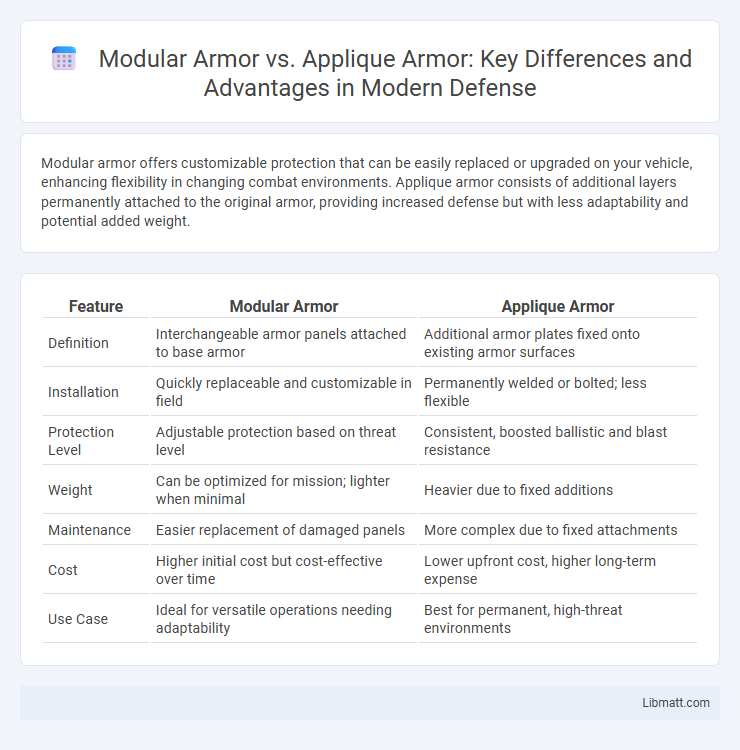Modular armor offers customizable protection that can be easily replaced or upgraded on your vehicle, enhancing flexibility in changing combat environments. Applique armor consists of additional layers permanently attached to the original armor, providing increased defense but with less adaptability and potential added weight.
Table of Comparison
| Feature | Modular Armor | Applique Armor |
|---|---|---|
| Definition | Interchangeable armor panels attached to base armor | Additional armor plates fixed onto existing armor surfaces |
| Installation | Quickly replaceable and customizable in field | Permanently welded or bolted; less flexible |
| Protection Level | Adjustable protection based on threat level | Consistent, boosted ballistic and blast resistance |
| Weight | Can be optimized for mission; lighter when minimal | Heavier due to fixed additions |
| Maintenance | Easier replacement of damaged panels | More complex due to fixed attachments |
| Cost | Higher initial cost but cost-effective over time | Lower upfront cost, higher long-term expense |
| Use Case | Ideal for versatile operations needing adaptability | Best for permanent, high-threat environments |
Introduction to Modular and Appliqué Armor
Modular armor consists of interchangeable, pre-fabricated panels that can be quickly attached or replaced on military vehicles, enhancing flexibility and ease of repair in combat situations. Applique armor refers to additional armor plates applied over the base armor to increase protection against specific threats such as shaped charges or kinetic projectiles. Both systems are designed to improve survivability but differ in customization, deployment speed, and integration with existing armor structures.
Definitions: What is Modular Armor?
Modular armor consists of interchangeable, prefabricated panels or blocks that can be easily attached or replaced on military vehicles to enhance protection against various threats. This armor system allows for rapid customization and repair on the battlefield, providing flexibility based on mission requirements. Unlike applique armor, which is typically welded or fixed, modular armor offers significant adaptability in design and deployment.
Understanding Appliqué Armor
Applique armor consists of additional armor plates attached to a vehicle's existing armor to enhance protection against specific threats such as shaped charges and kinetic projectiles. Modular armor, by contrast, is designed as interchangeable components that can be quickly added or removed according to mission requirements, offering flexible defense customization. Understanding applique armor helps you recognize how it serves as a cost-effective upgrade for increasing survivability without redesigning the entire vehicle.
Key Differences Between Modular and Appliqué Armor
Modular armor consists of interchangeable panels designed for quick replacement and customization, enhancing battlefield adaptability. Applique armor involves fixed layers or plates added onto a vehicle's existing armor to increase protection but lacks flexibility in configuration. The primary difference lies in modular armor's ease of upgrade and repair compared to the permanent, often heavier, nature of applique armor enhancements.
Materials and Construction Techniques
Modular armor typically uses advanced composite materials such as ceramics, high-strength steel, and ultra-high molecular weight polyethylene arranged in interchangeable panels for rapid field repair and upgrade. Applique armor involves welding or bolting additional steel or composite plates onto existing armor to enhance protection without replacing the base structure. Construction techniques for modular armor emphasize lightweight, layered designs that balance mobility and defense, while applique armor focuses on straightforward, durable attachment methods to augment armor thickness and ballistic resistance.
Battlefield Adaptability and Flexibility
Modular armor offers superior battlefield adaptability by allowing rapid installation and removal of armor panels tailored to specific mission threats, enhancing vehicle survivability without permanent structural changes. Applique armor, typically fixed or semi-permanent, provides increased protection but lacks the flexibility for quick adjustments in response to evolving combat conditions. This dynamic customization of modular armor ensures optimal balance between mobility and protection, crucial for modern asymmetric warfare environments.
Protection Levels and Threat Environments
Modular armor offers customizable protection levels tailored to specific threat environments, allowing for quick upgrades or repairs to counter evolving ballistic threats. Applique armor provides a fixed enhancement to existing armor systems, typically designed to improve defense against specific projectile types or shrapnel without the flexibility for modification. The modular approach is ideal for dynamic combat zones requiring adaptable protection, whereas applique armor suits scenarios with known, stable threat profiles.
Maintenance, Repair, and Upgrading
Modular armor offers simplified maintenance and repair due to its interchangeable panels, allowing damaged sections to be quickly replaced without removing entire armor systems, which reduces vehicle downtime. Applique armor, often welded or bolted onto the base armor, requires more extensive disassembly for repairs or upgrades, increasing labor and time costs. Upgrading modular armor is more cost-effective and flexible, as new materials or technologies can be integrated into specific modules without reworking the entire armor structure.
Weight Impact and Mobility Considerations
Modular armor offers significant weight savings compared to applique armor, allowing for enhanced mobility and reduced fatigue during prolonged operations. The lightweight materials and customizable configuration of modular systems improve soldier agility without compromising ballistic protection. In contrast, applique armor adds bulk and weight to existing platforms, often restricting movement and decreasing overall operational effectiveness.
Future Trends in Vehicle Armor Technology
Modular armor systems provide enhanced adaptability and ease of repair compared to traditional applique armor, allowing rapid customization based on mission requirements. Future trends emphasize lightweight composite materials and smart armor technologies that integrate sensors for real-time threat detection and response, improving protection without compromising vehicle mobility. Your vehicle's survivability will increasingly depend on these advanced, scalable armor solutions that balance protection, weight, and operational flexibility.
modular armor vs applique armor Infographic

 libmatt.com
libmatt.com